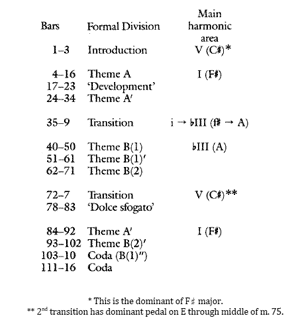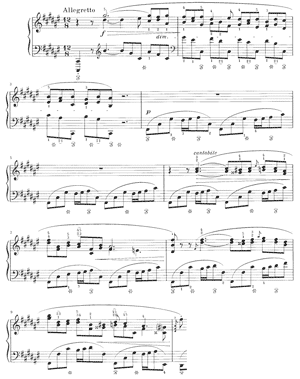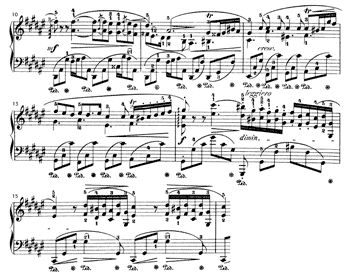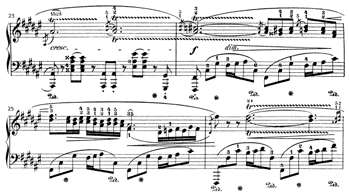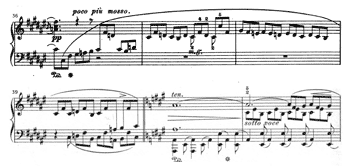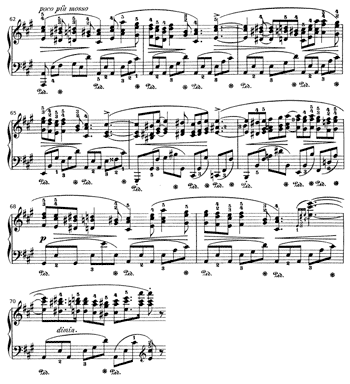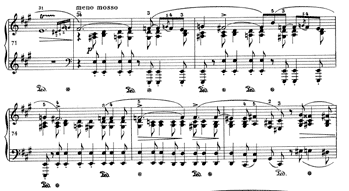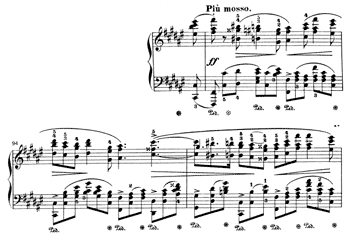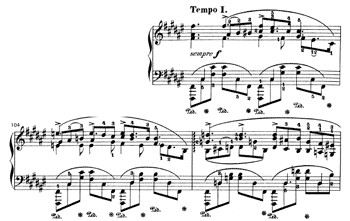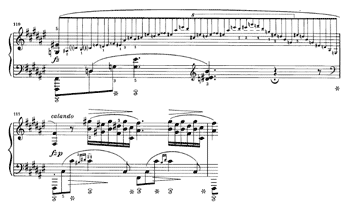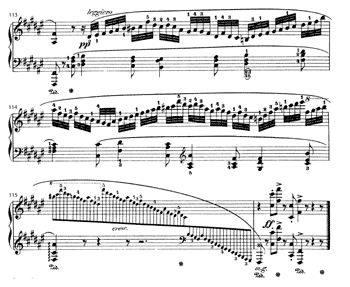On Performing Chopin’s Barcarolle
David Kopp
KEYWORDS: performance, analysis, Chopin, Barcarolle, piano, nineteenth-century music
ABSTRACT: This article focuses on the author’s experience relating musical analysis to performance issues in Chopin’s Barcarolle for piano. Central to the inquiry is an integrated perspective in which performance and analysis continually inform each other, with tangible results. Challenges to performance include the similarity and repetitiveness of textures and sectional characters over a long musical expanse; a succession of tightly packed, highly charged subsections toward the end; and significant structural and motivic events to be associated over spans of time. Analytic approaches reveal long-range motivic and pitch-class connections, directing the author’s attention to ways of performing significant events. A suggestive programmatic image drawn from personal experience aids in organizing distinctions of metric emphasis, texture, and gesture for a large portion of the piece. An examination of structural phrase-types in relation to conceptions of form helps to strategize the pacing of the final sections, leading to an unconventional performance decision.
Copyright © 2014 Society for Music Theory
[1] Frédéric Chopin’s masterful Barcarolle, op. 60, a late work from 1846, poses particular challenges to the performer.(1) Despite its many musical virtues, it presents a sprawling, idiosyncratic formal plan, a certain uniformity of texture and melody for roughly the first two-thirds of the piece, and a succession of short but dense, powerfully expressive subsections toward the end, all culminating in similarly strong cadential arrivals. In my own practice and performance of the piece, I felt certain shortcomings and the need for ideas to address them. Since I had not done so before, for the purposes of this study I set about analyzing the music to see what ideas might emerge. From the viewpoint of performance strategy, such an exercise could potentially address nagging trouble spots—the “problem-solving” mode identified by Jonathan Dunsby (1989, 8) and John Rink (2002, 39)—but it could also suggest fresh approaches to passages that had not seemed particularly problematic beforehand. Moreover, from my particular stance as a theorist of mid-nineteenth century chromatic harmony, a secondary interest in this exercise was to see if my conception of “common-tone tonality” might be relevant in some way.(2) In fact, all three types of outcomes materialized.
[2] Any inquiry of this type must necessarily engage with the issues raised by the relevant literature of the last few decades on the relationship of analysis to performance. The classic pitfalls are well-documented: the prioritization of the analyst’s way of thinking over the performer’s, with a certain disdain for the latter; the related dependence on analytic notions of musical structure foreign to typical performance lingo; and the tendency toward highly prescriptive conclusions dictating one preferred way of performing a passage, all epitomized in publications by Wallace Berry (1989) and Eugene Narmour (1988). Tempering this attitude was the prior claim by Janet Schmalfeldt that “there is no single, one-and-only performance decision that can be dictated by an analytic observation” (1985, 28).
[3] One can trace two broad and related lines of response to the analysis-informs-performance attitude of superiority. The first of these preserves one of its basic assertions, the existence of what John Rink has called “the vast terminological gulf between analysts and performers” (1990, 323), but draws different conclusions: rather than being inferior in musical understanding to academic analysts, performers have their own equally valid and highly developed means of conceiving and analyzing music, since after all they have been performing it convincingly for generations, and they, not the analysts, are the experts in this domain. From this viewpoint, performance has perhaps the greater potential to inform analysis than analysis does performance. Beyond this, the focus of inquiry has shifted toward discovering how performers think, act, and interact musically, in their own terms, while the abstract evidence of the score is supplemented by the concrete evidence of live and recorded performances, resulting in a fruitful and wide-ranging interdisciplinary outpouring of research.
[4] The second line of response takes a different and perhaps less radical tack, focusing less on the terminological gulf and the great divide it perpetuates, and instead viewing analysis and performance as having the potential to inform each other in limited but genuine ways, as complementary expressions of thinking and acting musically that can be embodied in collaboration or in the same individual. Joel Lester (1995, 198), Jonathan Dunsby (1989, 14), and Nicholas Cook have argued along these lines, with Cook noting a “new emphasis on the mutuality of the analyst/performer relationship” (1999, 245). With this shift, the more traditional piece-based performance-and-analysis study—less concerned with prescriptive recommendations for demonstrating structure-oriented analytical findings through performance, less bound by what Cook has called the theorist’s “paradigm of representation” (1999, 256), and mindful of the many other factors influencing the act of performance—remains viable. In a more recent special issue of this journal, Cook (2012) cites an article by Daphne Leong and David Korevaar (2005) as an example of the new model, in which the authors, as pianists and analysts, succeed in employing an integrated and balanced approach, although he has since tempered his praise on account of their analytic approach (2014, 42). The spirit of the earlier articles cited above is reflected in their approach: carefully reasoned analytic observations drawing on familiar theoretical concepts; detailed performance decisions involving articulation, emphasis, and timing; and the study of recorded performances for evidence of similar influence. What distinguishes the article from its predecessors is the presence of these authors’ complete musical selves. Most authors of the performance and analysis studies of the ‘80s and ‘90s were also accomplished performers. But striving to achieve the proper scholarly perspective of the time involved closing the door on the very aspect of themselves that presumably motivated the inquiry. Schmalfeldt’s (1985) solution to this dilemma, the artificial separation of her musical self into Analyst and Performer for the bold purpose of incorporating the performer’s own voice into music-theoretical discourse, stands as a sign of the times. Her experiment drew criticism both for a perceived bias toward the Analyst, and for the implication that the separation of the two personas was beneficial to scholarship.(3) A generation later, Leong and Korevaar achieved the symbolic opposite, melding the insights of two individuals into a single scholarly narrative in which analysis and performance mutually inform each other.
[5] I would like to position the present study modestly, to provide a further example of how analysis, in response to performance, can contribute positively to performance strategy. Limiting performance recommendations to my own playing should help to avoid the pitfalls of overly prescriptive language.(4) Expressing these recommendations on a conceptual rather than a technical level, where possible, should better allow for the multiple realizations implicit in Schmalfeldt’s dictum, quoted above. Treating performance, analysis, and my experience of the music as interdependent should guard against the tendency toward raising artificial distinctions. And beyond these aims, I hope that this study might offer some useful contribution to a general understanding of Chopin’s Barcarolle.
[6] This article addresses aspects of the piece from several analytic perspectives: form, harmonic structure, rhythm and meter, a landmark opening motive, and the fate of a referential pitch-class and pitch-class pair. Other perspectives interact with the analytic ones: Chopin’s dynamic and tempo indications and their variants, and an extramusical association stimulating the musical imagination. Rink’s (1988) comprehensive analysis of the Barcarolle will serve as a useful departure for the discussion, although my present concerns are different from his.
Example 1. Chopin, Barcarolle op. 60, formal structure
(click to enlarge)
Example 2. Barcarolle, background sketch
(click to enlarge)
[7] Example 1 shows Rink’s representation of the Barcarolle’s formal layout (1988, 197). A short introduction is followed by a tripartite section in tonic
Example 3. Barcarolle, introduction and beginning of theme A, measures 1–8
(click to enlarge)
[8] In his essay, Rink cites Gerald Abraham’s observation that Chopin’s introductions often seem to have no structural connections to the rest of the piece (Rink 1988, 218). Rink refutes this claim for the Barcarolle, based on linear motivic content and other factors. I will support and augment Rink’s argument using evidence of a different kind. First, though, let me introduce the personal, extramusical association that fueled my imagination. The barcarolle as a genre is, of course, a Venetian boat song. One of my most lasting impressions of a long-ago trip to Venice is of a sultry summer night that happened to be a festival day. Over the canals, fireworks repeatedly lit up the sky. Not until years later did this image occur to me as I played the opening measures of the Barcarolle: shot from below, the music lands high in the sky in a burst of pre-dominant energy, its sparkling parts slowly floating down through the air at slightly unequal speeds (Example 3).
[9] Since then the image has remained with me, hard to shake, despite the skepticism I’ve encountered from a minority of those with whom I’ve shared it. For the music of a composer widely regarded to have transcended the native associations of genres, a programmatic response to “barcarolle” may seem naïve. Nonetheless, the fireworks metaphor has helped me to articulate a question with implications for performance: does the Barcarolle begin in the water, or in the air? Does the introduction set the background character for the opening section, or does it set up a contrast against which the opening section defines its character? To me, the water imagery of the Barcarolle is conveyed in no small part by its lilting compound triple meter. Thus a “hydrocentric” introduction would initiate this lilt through accents and temporal stretching of the initial notes of each triplet group, defining a flexible, dotted-quarter pulse to be transmitted directly to the left-hand accompanimental figure supporting theme A. On the other hand, air is undifferentiated; it has no lilt, no pulse. Thus, an “aerocentric” introduction would proceed in even, unaccented values governed by an overall temporal shape, with the left hand accompaniment subsequently initiating the lilt as if from elsewhere. I wondered if there might be hydro-intro and aero-intro camps discernable in the recorded legacy of the piece. About a dozen different recordings, mostly historical, served as my initial basis for comparison—a small but representative sample that included classic renderings of the piece. Two of the recordings I knew best, the legendary Dinu Lipatti recording from 1948, and an Artur Rubinstein recording from about 1962, were exemplary: Lipatti is clearly hydro, and Rubinstein is definitely aero, whatever their own reasons for these approaches may have been. Audio Examples 1a and 1b demonstrate the different approaches: the reader may determine which is which.
Audio Example 1a. Barcarolle, measures 1–3 | Audio Example 1b. Barcarolle, measures 1–3 |
[10] All of the recordings I listened to were unique and pianistically appealing, making it clear that my analytical metaphor, used as the basis for defining character and pulse in the passage, could hardly be prescriptive. Moreover, implementing the decision in performance would be contingent on many other factors involved in making a performance decision, including the properties of individual instruments and acoustic environments. Nonetheless, all things being equal, my own tendency is toward aero rather than hydro, consistent with my image of Venetian fireworks, and a preference for contrast over continuation in setting the stage for the amount of material to follow. But I can also attempt to support my orientation analytically. Looking at the introduction’s harmonic and contrapuntal structure, we find a descending series of ![]()
![]()
Example 4. Barcarolle, continuation of theme A, measures 9–15
(click to enlarge)
Audio Example 2. Barcarolle, measures 4–15
[11] The introduction terminates with a conspicuous, unresolved melodic
[12] The preponderance of diminuendos over crescendos throughout the piece also serves, in principle, to encourage the performer not to overplay. Chopin’s own playing, from all reports, tended strongly toward the softer end of the dynamic spectrum, eschewing any harshness. He also traced a constant dynamic ebb and flow, rarely sustaining a single dynamic level.(9) Thus, his markings can be seen to reflect his own approach to performing the music. Nevertheless, a contemporary report on Chopin’s performance of the Barcarolle in his last public concert in 1848 marvels at the way he played the entire final section of the piece, measures 84–111, marked from forte to fortissimo in the score. In radical opposition to his own indications, Chopin maintained the music in a subtly nuanced pianissimo throughout that, according to the account, only the composer himself could bring off successfully in performance (see Eigeldinger 1998, 102–3). Chopin was well known for playing his own music differently at different times, on the spur of the moment (Eigeldinger 1998, 186–87n112). We might take this information as evidence justifying the performer’s carte blanche to disregard Chopin’s performance indications, much less to associate them with the results of analysis. Some of the historical recordings, particularly those from the earlier part of the twentieth century, display this attitude throughout.(10) However, thoughtful consideration of the sheer abundance and care given to these indications, and their intimate relation to the music as it unfolds, leads to the conclusion that they represent more than mere suggestions to be ignored. The performer has something to learn from them, even when choosing not to follow them all.
Figure 1. Barcarolle, harmonic reduction, measures 1–24; shifting chordal identity of
(click to enlarge)
[13] Looking further at the individual gestures comprising theme A, we find that the first three all terminate on the same
[14] At the end of theme A, the prominent ![]()
[15] This is one passage that I had never been able to get to feel right despite repeated attempts at figuring it out. As part of this study, I decided to consult earlier editions of the piece to see if the variants in dynamic and articulation markings that are typical for Chopin editions might provide some clues for improving my interpretation (see note 8). In the Henle edition I had been using, there is a forte marking on the first beat of measure 14, and the right-hand chord on the second beat carries an accent above, indicating a stress greater than that on the first beat.(13) The Paderewski edition from which I had originally learned the piece contains a more explicit crescendo to a forte marking on the second beat. However, the markings in the first editions and the nineteenth-century editions I consulted differ significantly from those in the modern editions. The English and German first editions are consistent in indicating forte at the beginning of measure 14 rather than on the second beat, while the French edition places the forte marking in the middle of the first beat, with an immediate diminuendo before the onset of the second beat.(14) Neither the first editions nor the nineteenth-century editions cited here contain the second-beat accent; instead, they have a diminuendo hairpin beginning anywhere from right after the downbeat to the beginning of the second beat, indicating some degree of lighter stress on the second beat than on the first (see Example 4, which follows the English first edition). This suggests a performance effect that would be lost by following the modern markings. In the build-up to the cadential ![]()
![]()
Audio Example 3. Barcarolle, measures 12–17
Example 5. Barcarolle, theme A', measures 23–35
(click to enlarge and see the rest)
Figure 2. Barcarolle, harmonic reduction, measures 24–39; continued shifting chordal identity of
(click to enlarge)
Example 6. Barcarolle, first transition and theme B(1), measures 35–51
(click to enlarge and see the rest)
Figure 3. Barcarolle, harmonic reduction, measures 39–51; series of tonicizations leading away from and back to A major
(click to enlarge)
[16] The music next moves sequentially through B major to land on an extended
[17] Theme A (Rink’s A') returns at measure 24 in a somewhat heightened setting of double trills, melodic diminution, and textural amplification, this time concluding squarely in the tonic key, creating further new meanings for
[18] The long section that follows establishes A major as the Barcarolle’s principal secondary key. From a Schenkerian perspective,
[19] The accompaniment, with figuration that articulates the dotted-quarter rather than dotted-half note, embodies these choppier waters. If one thinks along conventional lines and regards A major as dissonant within
Audio Example 4a. Barcarolle, measures 41–44 | Audio Example 4b. Barcarolle, measures 41–44 |
Example 7. Barcarolle, theme B(2), measures 62–70
(click to enlarge)
Figure 4. Barcarolle, similarities in themes’ first phrases: a), theme A; b), theme B(2); c), dolce sfogato theme
(click to enlarge)
Example 8. Barcarolle, arrival on
(click to enlarge and see the rest)
Figure 5. Barcarolle, harmonic reduction, measures 75–76, showing shifting chordal identity of
(click to enlarge)
[20] Following theme B(1)’s repetition, theme B(2) appears at measure 62, the music now entirely in A major (Example 7). This new theme, despite its quicker tempo, is perceptibly similar to theme A. The first phrases of both themes are framed by members of the tonic triad, having structural stepwise descents from local at the beginning to local at the end, along with prominent upward leaps of a minor sixth from local to local in the middle (here filled in by arpeggiation). Whereas the single stepwise descent of theme A’s first phrase happens at the end, theme (B)’s first phrase has two stepwise descents: one right at the beginning, and a second, less direct one at the end (Figure 4).(21) There are further similarities: the accompaniment of theme B(2) returns to the half-measure units of theme A, and most of its melodic phrases also end on , which is now
[21] This dominant pedal, though, eventually leads away from the key, which is ultimately relinquished though a chromatic descent that drives another distinctive process of melodic common-tone redefinition. At measure 75, as depicted in Figure 5,
[22] The exquisite dolce sfogato section follows at measure 78. Sfogato indicates a light and delicate manner of playing. The section begins with a familiar element: the
Example 9. Barcarolle, theme B(2)', measures 92–101
(click to enlarge and see the rest)
Figure 6. Barcarolle, harmonic reduction, measures 96–101; further shifting intervallic identities of
(click to enlarge)
Example 10. Barcarolle, theme B(1)'', measures 103–11, with emphasized intervallic cadence
(click to enlarge and see the rest)
[23] Toward the end of the dolce sfogato, the music proceeds through a chromatic bass ascent that prepares the return of themes A and B(2), heard in apotheosis at measures 84 and 93 respectively. Both are now further enhanced texturally, dynamically, and, in the case of theme B(2), harmonically. This expressive intensification is reinforced temporally, as Chopin restates the original material in a highly condensed format (refer back to Example 1). Theme A appears for the first time without its diminuendo at the beginning, as if liberated from constraint. Theme B(2) is now stated in tonic ![]()
[24] What follows is an extended, highly chromatic tonic pedal point (Example 10). The prevailing performance tradition for this eight-measure passage is for the pianist to treat it like a coda, like closing material pulling well back dynamically and expressively from the previous section and gradually winding down toward the augmented-sixth filigree in measure 110. Rubinstein’s 1962 recording provides a classic example of this treatment. Yet Chopin writes sempre f for the passage, without supplying any of the plentiful, nuanced dynamic markings that characterize virtually every other passage in the piece.(23) Rink notes that this section, which he calls the first coda, contains the Barcarolle’s only true four-bar phrases (Rink 1988, 214). The hypermetric regularity, reinforced by the relative suspension of dynamic ebb and flow and the insistent measure-by-measure rhythmic repetition within four-measure cadential phrases, allows for a process of intensification unmatched anywhere else in the piece. As mentioned previously, the return up to measure 103 is highly attenuated, lasting only nineteen measures versus seventy-one in the original, which leaves plenty of space for further activity. The trills and crescendo of measure 106 clearly intensify toward the second four-bar phrase, during which harmony becomes denser, more chromatic, and dissonant than ever before in the piece. For all of these reasons I would suggest that this is not closing material; formal process is still active here. Whereas the previous cadence at measure 103 provided a dramatic harmonic arrival, measures 110–11 provide a dramatic contrapuntal arrival, set into motion at the downbeat of measure 110 by the extremely dissonant augmented sixth heard against its own octave of resolution below, and resolving into that octave in its own register at the following downbeat. Interestingly, the only difference between Jim Samson’s (1985) analysis of the Barcarolle’s form and Rink’s (1988) occurs at just this point. Samson includes the
Audio Example 5a. Barcarolle, measures 110–111 | Audio Example 5b. Barcarolle, measures 110–111 |
Example 11. Barcarolle, intervallic cadence with fz markings, measures 110–11
(click to enlarge and see the rest)
Example 12. Barcarolle, coda, measures 113–116
(click to enlarge and see the rest)
[25] The typical performance of the pedal passage, embodying decreased energy and drive, initiates the filigree of measure 110 at a moderate dynamic level, then either relaxes the tempo and dynamics during the ascent or else races up in a sparkling shimmer. Rounding the registral apex, it characteristically dissipates on the way down to a very soft landing. My performance in Audio Example 5a approximates this approach. Accordingly, at least one edition from the late nineteenth century actually moves Chopin’s calando indication back from the beginning of measure 111, after the cadential arrival, to the start of measure 110, while others introduce hairpins to the gesture and, in one case, a ritenuto marking.(26) In contrast, all first editions of the Barcarolle, despite their differences, continue the sempre f through measure 110 with nothing expressly indicated for the filigree, followed by a stress on the arrival at the downbeat of measure 111: perhaps a last, dissonant rocket zooming into the air and landing with a noticeable impact.(27) The modern Henle and Ekier editions reproduce the most forceful of the first-edition alternatives (Example 11), and my rendition of this approach is in Audio Example 5b. Of course, this is not to say that the filigree should ever be played unrelentingly forte and fast without nuance and grace; it must be supple and true to style. But having always shaped this passage in the conventional way as a retreat, I am rethinking my approach to maintain intensity and imbue the filigree with the energy of an arrival. Thus analysis, coupled with a bit of research, has led to a performance decision of consequence, against the common grain, that would not otherwise have been considered. Among my select group of recordings, a relatively recent one by Alicia de Larrocha from 1995 does come close to this effect, and there are doubtless others as well.
[26] After this event, the Barcarolle’s coda (or second coda, depending on one’s analytic stance) wraps things up by invoking three of the piece’s signature motives in turn; see Example 12. First, at measure 113, a closing tenor theme played by the inner fingers of the left hand traces an octave emanating upward from
[27] Over the course of this essay I have attempted to demonstrate ways in which analysis can act in concert with other modes of thought and action in preparing the performance of a work of music. There are multiple types of analytic observation, involving rhythm and meter, harmony and counterpoint, common-tone and voice-leading relations, pitch-class and intervallic motives, and formal process. Most of the discussions of specific passages draw on a combination of these types. In the discussions, analysis interacts with other considerations in different ways and in different sequences, with varying paths through performance issues, analytic insights, study of scores and sources, extramusical images, and performance solutions, creating a mix of ideas and approaches specific to this particular piece. The decision to present the content in the chronological order of events was deliberate: organizing by analytic topic or mode of inquiry would inhibit the ability to communicate both this richness of interaction and a sense of the whole.
[28] To maintain a balance of perspectives, I have confined the analysis for the most part to those observations that address or are linked to issues of performance. I have left some analytic tools in the toolbox as they are not relevant to my focus, and some of my analyses are not as thorough as they would be if undertaken for other purposes. I have warded off unduly prescriptive conclusions by limiting performance directives to my own use, although the reader may find interest in some of those directives, and were I teaching the piece in the studio I would encourage students to test them out. Likewise, I have avoided negative evaluations of the cited recordings. I do not advocate for my reading of the piece as the preferred one, but simply document what I consider to be improvements in my own playing. Where my own experience bears on a discussion, I have described it. My hope is that the reader will come away from this article with a respect for the positive effects that analysis can bring to performance, and performance to analysis, as well as an enhanced appreciation of one of Chopin’s most admired works.
David Kopp
Boston University School of Music
855 Commonwealth Avenue
Boston, MA 02215-1303
dako@bu.edu
Works Cited
Berry, Wallace. 1989. Musical Form and Musical Performance. New York: W. W. Norton.
Blum, David. 1980. Casals and the Art of Interpretation. Berkeley: University of California Press.
Caplin, William. 1998. Classical Form: A Theory of Formal Functions for the Instrumental Music of Haydn, Mozart, and Beethoven. Oxford: Oxford University Press.
Cone, Edward T. 1968. Musical Form and Musical Performance. New York: W. W. Norton.
Cook, Nicholas. 1999. “Analyzing Performance, Performing Analysis.” In Rethinking Music, ed. N. Cook and M. Everist, 239–61. Oxford: Oxford University Press.
—————. 2012. “Introduction: Refocusing Theory.” Music Theory Online 18, no. 1.
—————. 2014. Beyond the Score: Music as Performance. Oxford: Oxford University Press.
Dunsby, Jonathan. 1989. Guest Editorial: “Performance and Analysis of Music.” Music Analysis 8, nos. 1–2: 5–20.
—————. 1995. Performing Music: Shared Concerns. Oxford: Oxford University Press.
Eigeldinger, Jean-Jacques. 1998. Chopin vu par ses élèves. Boudry-Neuchâtel: La Baconnière.
Hatten, Robert. 2014. “Performing Expressive Closure in Structurally Open Contexts: Chopin’s Prelude in A Minor and the Last Two Dances of Schumann’s Davidsbündlertänze.” Music Theory Online 20, no. 4.
Hauptmann, Moritz. 1853. Die Natur der Harmonik und der Metrik. Leipzig: Breitkopf und Härtel.
Hepokoski, James, and Warren Darcy. 2006. Elements of Sonata Theory. Oxford: Oxford University Press.
Higgins, Thomas. 1966. Chopin Interpretation: A Study of Performance Directions in Autographs and Other Sources. PhD diss., University of Iowa.
Kopp, David. 2002. Chromatic Transformations in Nineteenth-Century Music. Cambridge: Cambridge University Press.
Leong, Daphne, and David Korevaar. 2005. “The Performer’s Voice: Performance and Analysis in Ravel’s Concerto pour la main gauche.” Music Theory Online 11, no. 3.
Lester, Joel. 1995. “Performance and Analysis: Interaction and Interpretation.” In The Practice of Performance, ed. John Rink, 197–216. Cambridge: Cambridge University Press.
McCreless, Patrick. 2011. “The Pitch-Class Motive in Tonal Analysis: Some Historical and Critical Observations.” Res Musica 3: 52–67.
Milhous, Judith, and Robert D. Hume. 1985. Producible Interpretations: Eight English Plays 1675–1707. Carbondale: Southern Illinois University Press.
Narmour, Eugene. 1988. “On the Relationship of Analytical Theory to Performance and Interpretation.” In Explorations in Music, the Arts, and Ideas: Essays in Honor of Leonard B. Meyer, ed. Leonard B. Meyer, Eugene Narmour, and Ruth A. Solie, 317–40. Stuyvesant, NY: Pendragon Press.
Poli, Roberto. 2010. The Secret Life of Musical Notation: Defying Interpretive Traditions. Milwaukee: Amadeus Press.
Rink, John. 1988. “The Barcarolle: Auskomponierung and Apotheosis.” In Chopin Studies, ed. Jim Samson, 195–220. Cambridge: Cambridge University Press, 1988.
—————. 1990. Review of Musical Structure and Performance by Wallace Berry. Music Analysis 9, no. 3.
—————. 2002. “Analysis and (or?) Performance.” In Musical Performance: A Guide to Understanding, ed. John. Rink, 35–58. Cambridge: Cambridge University Press.
Rothstein, William. 1995. “Analysis and the Act of Performance.” In The Practice of Performance, ed. John Rink, 217–40. Cambridge: Cambridge University Press.
Samson, Jim. 1985. The Music of Chopin. London and Boston: Routledge and Kegan Paul.
—————. 1996. Chopin. New York: Schirmer Books.
Schmalfeldt, Janet. 1985. “On the Relation of Analysis to Performance: Beethoven’s Bagatelles Op. 126, Nos. 2 & 5.” Journal of Music Theory 29, no. 1: 1–31.
—————. 2005. “Response.” Music Theory Online 11, no. 1.
Schenker, Heinrich. (1935) 1979. Der freie Satz, Translated by E. Oster as Free Composition. New York: Longman.
Chopin, Barcarolle, op. 60, editions cited
Chopin, Barcarolle, op. 60, editions cited
Ekier, Karl, ed. 2002. Complete Works of Chopin, vol. 12. Warsaw: PWM edition.
First (English) edition. 1846. London: Wessel & Co.*
First (French) edition. 1846. Paris: Brandus & Cie.*
First (German) edition. 1846. Leipzig: Breitkopf & Härtel.*
Herttrich, Ernst, ed. 1978. Frédéric Chopin: Klavierstücke. Munich: G. Henle Verlag, 86–97.
Klindworth, Karl, and Xaver Scharwenka, eds. 1882. In Chopin, Complete Piano Works, vol. 10. London: Augener Editions , n.d., n.p.*
Kullak, Theodore, ed. 1882. In Friedrich Chopin’s Werke, Instruktiv Ausgabe, Band XIII. Berlin: Schlesinger'sche Buch-und Musikhandlung, 38–45.*
Mikuli, Carl, ed. 1895. In Frédéric Chopin, Complete Works for the Pianoforte, vol. 10. New York: G. Schirmer, 9–19.*
Paderewski, Ignacy, Ludwik Bronarski, and Józef Turczyński, eds. 1954. Frédéric Chopin: Complete Works (Fryderyk Chopin Dziela Wszystkie), vol. XI. Warsaw: Instytut Fryderyka Chopina, (printed Cracow, 1975), 31–40.
Scholtz, Hermann, ed. 1879. In Fr. Chopin Sämtliche Pianoforte-Werke, Band III. Leipzig: C.F. Peters, n.d., 9–19.*
*Accessed at Chopin’s First Editions Online, http://www.cfeo.org.uk.
**Accessed at Petrucci Music Library, IMSLP, http://imslp.org/wiki/Barcarolle,_Op.60_(Chopin,_Frédéric)
Manuscript facsimile images accessed at:
http://en.chopin.nifc.pl/institute/publications/facsimile/id/646
Original in the Jagiellonian Library, Kraków.
http://pressandpolicy.bl.uk/Resource-Library/First-page-of-Chopin-s-famous-Barcarolle-1845-f5.aspx
Original in the British Library, London.
*Accessed at Chopin’s First Editions Online, http://www.cfeo.org.uk.
**Accessed at Petrucci Music Library, IMSLP, http://imslp.org/wiki/Barcarolle,_Op.60_(Chopin,_Frédéric)
Manuscript facsimile images accessed at:
http://en.chopin.nifc.pl/institute/publications/facsimile/id/646
Original in the Jagiellonian Library, Kraków.
http://pressandpolicy.bl.uk/Resource-Library/First-page-of-Chopin-s-famous-Barcarolle-1845-f5.aspx
Original in the British Library, London.
Discography
Discography
Ashkenazy, Vladimir. 1968. Decca 591089.
de Larrocha, Alicia. 1995. RCA Red Seal 68959.
Lipatti, Dinu. 1948. Columbia 33CX 1386.
Rubinstein, Artur. 1999. EMI 1928, reissued in Rubinstein Collection, vol. 4, RCA Red Seal 62000.
Rubinstein, Artur. 1962. RCA 5617-2-RC.
Footnotes
1. This article is an expansion of a talk originally given in December 2008 at a conference held at Princeton University in memory of Edward T. Cone, and in a revised version in November 2010 as part of a special session on performance and analysis of nineteenth-century music at the Society for Music Theory annual meeting in Indianapolis.
Return to text
2. See Kopp 2002, 1–17.
Return to text
3. Schmalfeldt, summarizing and reflecting on these criticisms some two decades later, asserted that her attempt was to create “an utterly equal partnership” between her alter egos, noting that “I assumed that both of my characters would be easily recognized as aspects of myself” (2005, [3]).
Return to text
4. “Prescriptive” does not necessarily imply a negative value, insofar as any performance decision resulting from analysis can be thought of as prescriptive (see Rink 2002, 37).
Return to text
5. Thoroughly updating these analyses with respect to recent theories of sonata form would be an illuminating exercise that I will not accomplish here, although some clear correspondences will be identified.
Return to text
6. The structure of this tripartite section conforms to William Caplin’s (1998, 71) definition of the small ternary theme-type, characteristic of a range of forms.
Return to text
7. For one description of the practice, see Blum 1980, 15–22.
Return to text
8. The analysis of this passage, inspired by a performance question, in turn inspired some research. The issue of dynamic and articulation markings in Chopin’s music is complex, full of variants in manuscripts, first editions, and later editions; in many cases no single source can be taken as definitive. Even with modern critical editions, it can be instructive for the performer to study the sources and earlier editions to ponder the range of alternatives in problematic passages—a reminder that the score can provide only so much information about a piece, and that the idea of a piece changes over time. In measure 6 of the Barcarolle, well-known twentieth-century editions such as Paderewski and Henle/Herrtrich, from which I learned the piece, continue the diminuendo through to the downbeat of measure 7, the registral and metric high point of the gesture. This appears to run directly contrary to the natural phrase arching and creates an interpretive paradox. See for example Poli 2010, 6–7, although an agogic stress would still be possible at the end of the diminuendo. However, all three first editions of the Barcarolle, from 1846, have differing information. The French edition has the diminuendo extending only to the beginning of the fourth beat of measure 6, while the German edition has the diminuendo extending to the second eighth note of the fourth beat. The English edition lacks any diminuendo. Late nineteenth-century editions such as Peters/Scholtz 1880 and Schirmer/Mikuli 1895 also have diminuendos ending at or in the fourth beat, as does the recent National Edition, edited by Jan Ekier. This alternative leaves room at the end for a subdued but noticeable rise to the high point, with dynamic and agogic stress appropriate to this first in a series of related gestures at the beginning of the piece.
Return to text
9. See Higgins 1966, 77, based on a contemporary report.
Return to text
10. Artur Rubinstein’s fiery performance from 1928 is exemplary of this approach, in contrast with his later recordings.
Return to text
11. A pitch class can be understood as “motivic” if it returns in prominent, varied, and marked ways over the course of a movement or piece. McCreless (2011) traces the rise in usage of this term, first articulated by Steve Laitz in 1992.
Return to text
12. Rink, in the analysis shown in Figure 2 (1988), identifies
Return to text
13. The more recent National/Ekier edition has the same markings.
Return to text
14. There are two extant autograph manuscripts of the Barcarolle, both engraver’s copies. One autograph is consistent with the French first edition in measure 14. The other autograph is nearly consistent with the German first edition, although the diminuendo begins on the third eighth note of the first beat in the autograph, and on the second eighth in the print edition.
Return to text
15. The potential gain for the listener was also instantly demonstrated, as a family member familiar with my performance of the piece happened to listen in at that moment, and declared, “Wow, that sounded good!”
Return to text
16. The mid-beat climax suggested by the French first edition suggests an enhancement to this performance approach, setting up an unfulfilled expectation of stress on the second beat.
Return to text
17. Continuing the sonata analogy, this passage would represent the medial caesura (Hepokoski and Darcy 2006, 23–50). After this point, though, while the analogy can be extended, formal organization becomes more idiosyncratic.
Return to text
18. The Neo-Riemannian operations for the two relationships are similar: PL for
Return to text
19. Likewise, in the return from A major to
Return to text
20. Kopp 2002, 5–8, 18–32.
Return to text
21. The analyst could readily enough produce more comprehensive diagrams than those in Figure 4 to account for the structural status of every note in themes A, B(2), and the sfogato theme. But this level of detail is not necessary for the performer to understand the thematic similarities.
Return to text
22. The diminuendo and ritenuto are not present in all editions.
Return to text
23. The French first edition has f marked at measure 103, a crescendo hairpin extending throughout measure 106, and sempre f at measure 107. The English and German editions have sempre f marked immediately at measure 103, the crescendo hairpin throughout measure 106, and nothing afterwards, suggesting a ff dynamic level. Both variants appear in later editions about equally. But in all cases an unbroken intensification is indicated.
Return to text
24. Samson subsequently abandoned this analysis, agreeing with the formal closure indicated in Rink’s Schenkerian graph (Samson 1996, 267).
Return to text
25. There is a potential resonance here with the notion of structural vs. expressive closure that Robert Hatten introduces in this issue (Hatten 2014). While I am arguing that in the Barcarolle both measures 103 and 111 participate in a process of structural closure, each has a different quality.
Return to text
26. Mikuli 1895, Kullak 1882, and Klindworth and Scharwenka 1882 respectively.
Return to text
27. The various editions show great variability here at one of the most dramatic moments of the piece. The French first edition has nothing at measure 110 b1, continuing the sempre f of measure 107, and sf followed by p at measure 111 b1. The English edition has sf at both measures 110 b1 and 111 b1, followed by p in the latter. The German edition has nothing at measure 110 b1, and fp at measure 111 b1. All of these variants found their way into later editions. The Peters/Scholtz shown in Example 10 follows the German, while the Henle/Herrtrich shown in Example 11 follows the English, with stress on both downbeats—my own preference, since this highlights the intervallic resolution.
Return to text
Copyright Statement
Copyright © 2014 by the Society for Music Theory. All rights reserved.
[1] Copyrights for individual items published in Music Theory Online (MTO) are held by their authors. Items appearing in MTO may be saved and stored in electronic or paper form, and may be shared among individuals for purposes of scholarly research or discussion, but may not be republished in any form, electronic or print, without prior, written permission from the author(s), and advance notification of the editors of MTO.
[2] Any redistributed form of items published in MTO must include the following information in a form appropriate to the medium in which the items are to appear:
This item appeared in Music Theory Online in [VOLUME #, ISSUE #] on [DAY/MONTH/YEAR]. It was authored by [FULL NAME, EMAIL ADDRESS], with whose written permission it is reprinted here.
[3] Libraries may archive issues of MTO in electronic or paper form for public access so long as each issue is stored in its entirety, and no access fee is charged. Exceptions to these requirements must be approved in writing by the editors of MTO, who will act in accordance with the decisions of the Society for Music Theory.
This document and all portions thereof are protected by U.S. and international copyright laws. Material contained herein may be copied and/or distributed for research purposes only.
Prepared by Brent Yorgason, Managing Editor
Number of visits:
24777
